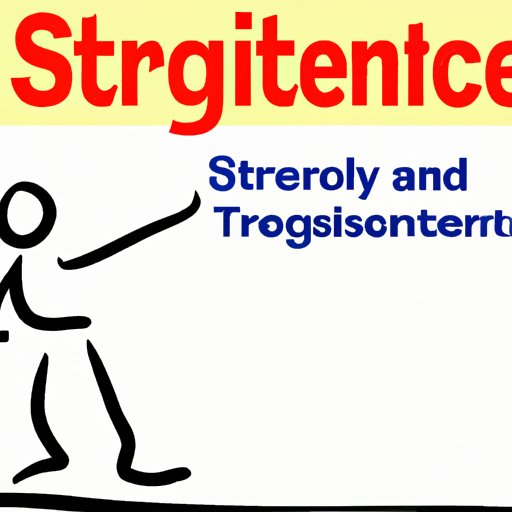Introduction
When it comes to writing, having a strong stance is essential. A stance is the overall position that you take on a specific issue or topic. It is important to have a clear stance when writing because it helps to establish credibility and engages the reader. In this article, we will explore what is a stance in writing, provide examples of different types of stances, discuss strategies for crafting a compelling stance, and examine the benefits of establishing a clear stance in writing.

Exploring Examples of Different Types of Stances in Writing
When it comes to writing, there are four main types of stances: neutral, persuasive, argumentative, and critical. Let’s explore each one in more detail.
Neutral Stance
A neutral stance is when you take no particular side in an argument. You simply present facts without making any value judgments. For example, if you were writing an article about the effects of global warming, you would present information about the causes and consequences of climate change without taking a stance on whether it is good or bad.
Persuasive Stance
A persuasive stance is when you attempt to convince the reader to agree with your opinion. You use facts and logical arguments to persuade the reader to see things from your perspective. For example, if you were writing about the need for stricter gun control laws, you would present evidence and make a case for why such laws should be enacted.
Argumentative Stance
An argumentative stance is when you take a stance on an issue and attempt to refute opposing arguments. You use facts and logical arguments to support your position and try to disprove the opposing side. For example, if you were writing about the death penalty, you would present evidence and make a case for why the death penalty should be abolished while also refuting any arguments in favor of its use.
Critical Stance
A critical stance is when you take a stance on an issue and analyze it from multiple perspectives. You look at the issue from various angles and evaluate the pros and cons of each argument. For example, if you were writing about the impact of technology on society, you would look at the positive and negative effects of technology and draw conclusions based on your analysis.
Analyzing How to Determine the Appropriate Stance for an Article
Once you have identified the type of stance you want to take, the next step is to determine the appropriate stance for your article. Here are a few tips to help you do that:
Consider Your Audience
Before you start writing, it is important to consider who your audience is. This will help you determine which stance to take and how to frame your argument. You may want to take a more persuasive stance if you are trying to convince your audience to take action, or a more critical stance if you are trying to provide a balanced analysis of an issue.
Examine the Topic
You should also take some time to examine the topic you are writing about. Consider the different perspectives on the issue and decide which one best aligns with your own beliefs. This will help you determine the stance you should take and the points you should focus on.
Research Sources
Finally, it is important to research sources to find evidence to support your stance. Look for reputable sources that provide factual information and credible arguments. This will help you craft a more compelling and convincing stance in your writing.

Investigating Strategies for Crafting a Compelling Stance in Writing
Now that you have determined the appropriate stance for your article, it is time to start writing. Here are a few strategies you can use to craft a compelling stance in your writing:
Choose Two or Three Key Points
First, you should choose two or three key points to focus on in your writing. These should be points that you can use to effectively support your stance and make your argument more convincing. Make sure to include facts and evidence to back up your points.
Support Your Position with Evidence
It is also important to support your position with evidence. This could include statistics, quotes from experts, or anecdotes. The evidence you provide should be relevant and reliable. Be sure to cite any sources you use to give credit where credit is due.
Use Logical Reasoning
Finally, make sure to use logical reasoning in your writing. This means presenting your argument in a way that makes sense and is easy to follow. Use transitions between paragraphs to ensure your argument flows logically. This will make it easier for the reader to understand and appreciate your stance.

Examining the Benefits of Establishing a Clear Stance in Writing
Establishing a clear stance in writing has many benefits. Here are a few of them:
Increase Credibility
Having a clear stance in your writing can help to increase your credibility. By taking a firm stance on an issue and backing it up with evidence, you demonstrate that you have done your research and can be trusted to provide accurate information.
Strengthen Your Argument
Establishing a clear stance can also strengthen your argument. By providing evidence to support your stance, you make it harder for the reader to disagree. This makes it easier for you to persuade the reader to see things from your perspective.
Engage Your Audience
Finally, having a clear stance can help to engage your audience. When you take a strong stance on an issue, it gets readers thinking and encourages them to consider the implications of your argument. This can help to create a meaningful dialogue between you and your readers.
Conclusion
In conclusion, having a clear stance in writing is essential. It can help to increase your credibility, strengthen your argument, and engage your audience. When determining the appropriate stance for your article, consider your audience, examine the topic, and research sources. To craft a compelling stance, choose two or three key points, support your position with evidence, and use logical reasoning. Establishing a clear stance in writing can bring many benefits, so make sure to always have one when writing.
(Note: Is this article not meeting your expectations? Do you have knowledge or insights to share? Unlock new opportunities and expand your reach by joining our authors team. Click Registration to join us and share your expertise with our readers.)
